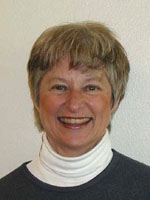
Susan Taylor
University of California at San Diego
Signal Transduction and Dunce Awards
The Cyclic Nucleotides Gordon Conference played a major role in shaping my career and also helped to define a new area of knowledge that has come to be a central dogma of signal transduction. When I first attended the conference in the early 1970s, I was a young assistant professor who had been trained as a protein chemist but who chose to work on a newly discovered protein: cyclic adenosine monophosphate (cAMP) - dependent protein kinase (PKA). My first Gordon Conference in 1972 was actually Enzymes, Coenzymes, and Metabolic Pathways, which was the primary Gordon Conference for enzymologists, protein chemists, and crystallographers. It was my natural scientific home. But shortly thereafter my interest drifted to PKA, and I decided that I needed to learn more about this new area.
At that time the G-proteins, which bind the guanine nucleotides, were just being discovered, and my first Cyclic Nucleotides Gordon Conference in 1974 was chaired by Al Gilman. Here I met lifetime friends Shmuel Shatiel, Ed Krebs, Eddie Fischer, Jackie Corbin, Al Gilman, Henry Bourne, Ora Rosen, and Bruce Kemp, to name only a few. And here I got to know the pioneers of the field and became acquainted with pharmacology. In retrospect I recognize how much this Gordon Conference helped forge a bridge in my career between protein chemistry, structural biology, and pharmacology. The conference became my intellectual home for many years.
The evolution of the name of the Cyclic Nucleotides Gordon Conference reflects the evolution of the field. Intellectually, the conference began with the discovery of cAMP by Earl Sutherland, who chaired the first conference in 1970. The discovery of G-proteins was revealed during the initial years of the Gordon Conference. The 1970s also saw the discovery of new kinases in addition to phosphorylase kinase, PKA, and the protein phosphatases that became part of the signaling equation. In the next decade the mitogen-activated protein (MAP) kinases and their cascades were discovered, and we learned that the insulin receptor was also a protein kinase. Eventually, the name of the conference was changed to Cyclic Nucleotides and Protein Phosphorylation.
Two branches of this Gordon Conference evolved, with the focus in one year on G-proteins and phosphodiesterases and in the alternate year on protein kinases and protein phosphorylation. The present title, Phosphorylation and G-Protein Mediated Signaling Networks, recognizes the two major facets of signal transduction: the G-protein-coupled receptors and signaling by protein phosphorylation.
My own research was influenced profoundly by the talks I heard in the early conferences and by the collaborations that resulted from afternoon discussions as we hiked and canoed. I chaired the conference in 1986 and attended regularly. At these conferences I heard about the latest discoveries. I remember most clearly the plenary lecture given by the late Ora Rosen where she talked about the insulin receptor and the differentiation of N1H3T3 cells into adipocytes. Her embracing of tissue culture made me also appreciate how important it is to learn new techniques that are driven by the science.
I have tried to follow this rule in my own career. When I first talked about trying to crystallize PKA, I was not taken very seriously by the GRC participants. In many ways I think I introduced structural biology into protein phosphorylation. I have been gratified to see how far we have come. I believe that my first talk about the protein kinase structure was at the Gordon Conference in 1991. Now, in this genomic era, we know that this is one of the largest gene families in mammalian genomes and over sixty protein kinase structures are available. Structural biology is now an integral and routine part of signal transduction.
One of the features that always made this Gordon Conference special is its interdisciplinary nature. It is a place where the disciplines of physiology, pharmacology, and biochemistry come together. It is also a meeting that specially fosters interactions with students and postdoctoral fellows.
Another highlight of this Gordon Conference is the “Dunce Awards.” I think they were initiated early on by Larry Brunton and Lee Witters. Tom Sturgill and Bruce Kemp became later contributors. For as long as I can remember, this was a much-anticipated event that took place in the bar after the evening plenary lecture. A “secret” committee worked diligently to present three or four Dunce Awards each year, complete with cone hats for the recipients. One noteworthy example defines the flavor of these awards. Roger Tsien received the award one year for “the blush of conception”–his demonstration, using FRET (fluorescence resonance energy transfer), of the intracellular wave of cAMP that was initiated by the fertilization of an egg by a sperm.
Spontaneity always characterized the scheduled and unscheduled events at this Gordon Conference, and the combination created a unique environment. It brought together the conference attendees scientifically and socially and certainly facilitated communication and advances in the field.